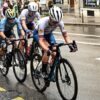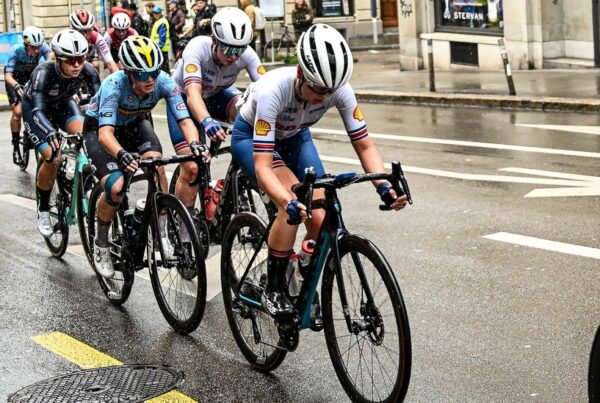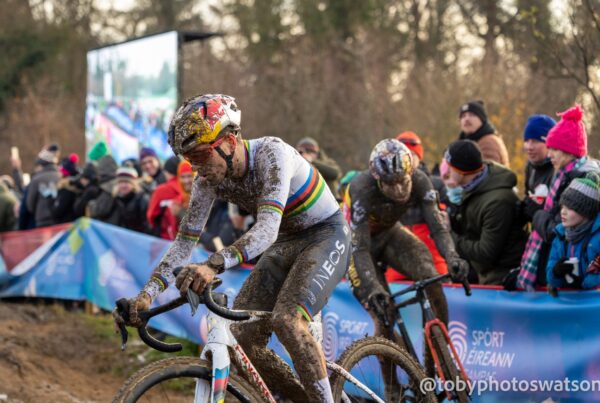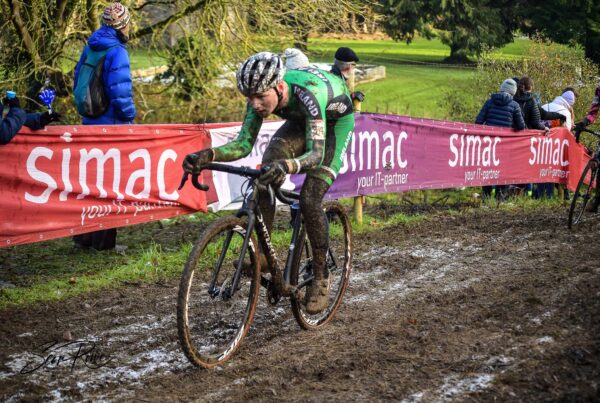
By Shane Stokes
Mia Griffin’s past year of racing is an example of the emotional rollercoaster athletes can face. There have been several big highs and lows over the last 12 months or so.
She and the Irish team pursuit squad are currently looking good to qualify for the Olympic Games, and she also clocked up some very impressive road results at the end of 2023.
But there was a long period during the season where she was sidelined and unsure when she would be able to compete again. A crash in Paris-Roubaix Femmes on April 4th gave her concussion, and led to her not finishing the Ronde de Mouscron two days later.
Unable to train for a long period, she missed the Irish time trial and road race championships last June because of lingering effects of the head injury. When she eventually returned to international racing in August she was a non-finisher in three successive events.
Some riders might have called quits on the season, but she kept plugging away. That would eventually pay off with the best road results of her career.
Griffin has spoken about that period, detailing just what she went through and also what her recovery entailed. Looking back, she believes starting Mouscron two days after her head injury was a mistake.
“I felt like something was wrong, for sure. I said that I’d start the race, probably half out of a little bit of stupidity in a way,” she said. “I always really want to race, even sometimes when it’s bad for me. And I thought that it was not as bad as it was. But definitely racing two days later was a really bad idea.”
That wasn’t just down to her own desire to compete. UCI rules require a minimum roster turnout in events and that too contributed to the decision.
“It’s sometimes a problem as well with teams. You need to have a certain quota of riders for the team to be able to start the race. So they were caught a little bit in that predicament as well,” she continued.
“What I should have just done is roll over the start line and pull out straight away, but I just wanted to race too. I was like, ‘oh, no, I’ll be fine.’ And physically I felt quite okay. It was just the disorientation.”
Fortunately her friend and her-then Israel Premier Tech teammate Alice Sharpe—who is also part of the Irish team pursuit squad—was also competing, something which proved important.
“It was good having Alice there because she told me, ‘oh no, you need to get out of this race now.’”
She did, and that ended up being her last competitive event for over four months.
“I was getting very dizzy”
Griffin is just one of several Irish riders who have suffered concussions in recent years. Eddie Dunbar is another, the Jayco AlUla rider speaking before about the lingering issues he faced as a result.
Megan Armitage had two concussions last year, with one ruling her out of the Tour de France Femmes and the other contributing to her missing the European championships.
Daire Feeley, Matthew Devins and Aaron Rafferty are just some of the others who also went through the same sort of injury.
Griffin spoke about the symptoms she experienced in the wake of the fall, and about how they persisted long after she expected them to ease.
“After the crash, I carried on training a little bit, which was definitely a fault. I was training and getting very dizzy. Even when I’d stop at a traffic light or something, I’d be really, really disorientated. I had lot of headaches and really, really heavy fatigue.
“Initially, my team wanted me to ride the Vuelta. And I was like, ‘oh, I’ll be ready in like two weeks,’ when I went back from Belgium, after Roubaix and after Mouscron.
“But then after two weeks I just was not getting any better. I was not seeing any improvements in my symptoms.”
She advised by the Insititute of Sport to take things more easily. “After a few weeks I went back to Ireland and I started to properly try to recover there, but again it was kind of the same thing. I was not seeing big improvements in how I was feeling.
“I was still really, really tired to the point where I could maybe sometimes only do like 20, 30 minutes on the bike every day. I then built that up gradually to like, an hour with sub-130 heart rate, which is basically not really training.”
During that time Griffin said she spoke to Devins, who had lingering effects from his concussion. She said that others were also in contact too, with the general feeling of support helping her.
Being injured can be a very lonely experience, but talking to others who experienced the same thing gave her encouragement.
Symptoms triggered by motion
Interestingly, one of the biggest issues Griffin faced might seem unexpected to those who don’t know much about concussion.
“A lot of my problems were from the visual stimulus from, say, when I was on the bike, when things were moving in my periphery,” she said, referring to the blurring of movement to the left and right that riders experience while moving.
“That was really causing disruption. I had to do these VOMS [vestibular ocular motor screen – ed.] exercises, which retrain your eyes and, I think, your inner ear as well. Because sometimes they can be thrown off when you hit your head.
“By retraining that you can rehab a concussion, kind of similar to a normal injury. There was a school of thought that when you have a concussion, you just lie in a dark room and wait until it passes.
“But I think there’s a lot that you can actually do that is going to help you. Rest was definitely an important factor in it, but I think then once you go into the normal world, even going through a shopping centre is going to send you wildly bad with a concussion. It’s difficult to describe.”
Doing specific exercises with the Institute of Sport were helpful, as was work while undergoing treatment in Waterford and over in Switzerland.
Griffin worked closely with her coach Tommy Evans and said that this also proved vital. She described him as ‘key’, saying that he was checking in on her each day. Even if she was only able to train for an hour, his asking how things went for her meant she felt supported.
Time passed and things finally improved. But she did experience frustration at the length of time it took.
“After about three months, I thought, ‘oh, God, this is this is going to be a long one,’” she said. “And even in relation to the amount of fitness you lose as well. I was like, ‘that’s the season over, more or less.’
“But after getting some intensive treatment, I eventually came out of it. I then was able to train properly. I’d say it took five months for all the symptoms to be gone.”
That patience eventually paid off, with her frustration at missing events like the track worlds being channelled into her racing once it was safe to return to competition.
She began with a superb performance in her home county in Rás na mBan, with two stage wins boosting her confidence.
She then stepped up again internationally, landing eighth place on stage one of the Tour of Chongming Island and then a career-best third in the one day Tour of Guangxi.
The latter two events are part of the UCI WorldTour and were career-best rides in terms of her road racing career.
They also proved vital to Ireland’s Olympic hopes, with those two performances in China adding a considerable 270 points to the country’s tally.
That in turn boosted Ireland’s world ranking from 49th to 33rd, securing a place in the Olympic road race in Paris.
It was a storming—and highly motivating—end to the season, and set her up well heading into 2024. Griffin is in a much better place now and looks set for a strong year.
Last season brought considerable frustration, but giving herself time to heal fully and then knuckling down again really paid off.
.
.
.
#Mia #Griffins #concussion #stop #traffic #light #disorientated
Source link







